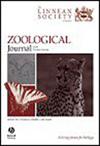蜥蜴的皮甲:骨皮比想象中更常见
IF 2.8
2区 生物学
Q1 ZOOLOGY
引用次数: 0
摘要
皮肤及其衍生物是大多数动物与外界环境的边界。尽管它的功能至关重要,但它的一些特征仍然鲜为人知。对于骨皮细胞来说尤其如此,骨皮细胞是皮肤上的骨板,在四足动物的生命树中广泛存在,但不一致。阐明它们的功能和进化历史需要系统的方法,但这受到缺乏一致和全面的骨皮表达目录的阻碍。在现存的四足动物中,有鳞爬行动物(蜥蜴和蛇)在形状、分布和表达方面拥有最大的骨皮多样性,因此代表了一个理想的研究系统。我们首次对鳞片类爬行动物的骨皮表达进行了定性研究。基于1339个微计算机断层扫描样本和584篇文献报道,我们在此报告了46%的蜥蜴属中存在骨真皮,使其比先前文献所显示的多85%。我们在Varanidae和Lacertidae中发现了实质性的差异,其中骨皮分别是常见的或普遍存在的。在整个有鳞爬行动物中,骨皮患病率达25%。我们的发现为未来的系统研究提供了基础,从而有可能为形成当今生物多样性的进化轨迹和限制提供新的见解。本文章由计算机程序翻译,如有差异,请以英文原文为准。
Dermal armour in lizards: osteoderms more common than presumed
Skin and its derivatives form the boundary with the external environment for most animals. Despite the vital character of its function, some of its features remain poorly understood. This is particularly the case for osteoderms, which are bone plates in the skin that occur widely but inconsistently throughout the tetrapod tree of life. Elucidating their function and evolutionary history requires systematic approaches, but this is hampered by the lack of a consistent and comprehensive catalogue of osteoderm expression. Squamate reptiles (lizards and snakes) harbour the greatest diversity of osteoderms in terms of shape, distribution, and expression among living tetrapods, and thus represent an ideal study system. We conducted the first qualitative investigation of osteoderm expression in squamate reptiles. Based on 1339 micro-computed tomography samples and 584 mentions in the literature, we report here osteoderms in 46% of lizard genera, making them 85% more common than prior literature suggests. We found substantial discrepancies with prior literature in the Varanidae and the Lacertidae, where osteoderms are common or ubiquitous, respectively. In squamate reptiles as a whole, osteoderm prevalence amounts to 25%. Our findings provide the groundwork for future systematic investigations, thus potentially providing new insight into evolutionary trajectories and constraints that shaped present-day biodiversity.
求助全文
通过发布文献求助,成功后即可免费获取论文全文。
去求助
来源期刊
CiteScore
6.50
自引率
10.70%
发文量
116
审稿时长
6-12 weeks
期刊介绍:
The Zoological Journal of the Linnean Society publishes papers on systematic and evolutionary zoology and comparative, functional and other studies where relevant to these areas. Studies of extinct as well as living animals are included. Reviews are also published; these may be invited by the Editorial Board, but uninvited reviews may also be considered. The Zoological Journal also has a wide circulation amongst zoologists and although narrowly specialized papers are not excluded, potential authors should bear that readership in mind.

 求助内容:
求助内容: 应助结果提醒方式:
应助结果提醒方式:


